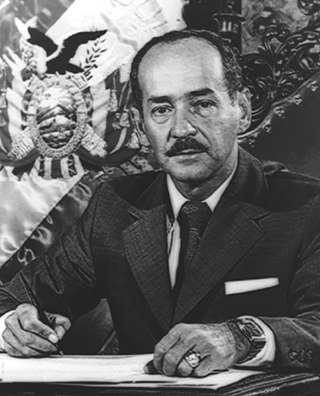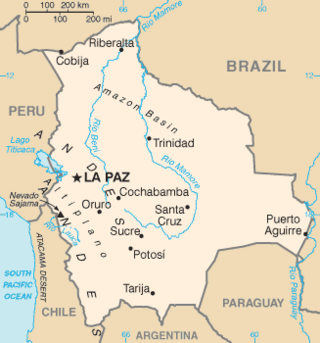Related Research Articles

Hugo Banzer Suárez was a Bolivian politician and military officer who served as the 51st president of Bolivia. He held the Bolivian presidency twice: from 1971 to 1978 as a military dictator; and then again from 1997 to 2001, as a democratically elected president.

The Revolutionary Nationalist Movement is now a centre-right, conservative political party in Bolivia. It was the leading force behind the Bolivian National Revolution from 1952 to 1964. It influenced much of the country's history since 1941.

Ángel Víctor Paz Estenssoro was a Bolivian politician who served as the 45th president of Bolivia for three nonconsecutive and four total terms from 1952 to 1956, 1960 to 1964 and 1985 to 1989. He ran for president eight times and was victorious in 1951, 1960, 1964 and 1985. His 1951 victory was annulled by a military junta led by Hugo Ballivián, and his 1964 victory was interrupted by the 1964 Bolivian coup d'état.

Hernán Siles Zuazo was a Bolivian politician who served as the 46th president of Bolivia twice nonconsecutively from 1956 to 1960 and from 1982 to 1985. He also briefly served as interim president in April 1952, and as the 27th vice president of Bolivia from 1952 to 1956.

Jaime Paz Zamora is a former Bolivian politician who served as the 60th president of Bolivia from 1989 to 1993. He also served as the 32nd vice president of Bolivia from October 1982 to December 1984 during the presidency of Hernán Siles Zuazo.

Juan Lechín Oquendo was a labor-union leader and head of the Federation of Bolivian Mine Workers (FSTMB) from 1944 to 1987 and the Bolivian Workers' Union (COB) from 1952 to 1987. He also served as the 29th vice president of Bolivia between 1960 and 1964.

The Bolivian Socialist Falange is a Bolivian political party established in 1937. It is a far-right party drawing inspiration from fascism. It was the country's second-largest party between approximately 1954 and 1974. After that, its followers have tended to gravitate toward the government-endorsed military candidacy of General Juan Pereda (1978) and, especially, toward the ADN party of former dictator Hugo Banzer.

The history of Bolivia from 1964 to 1982 is a time of periodic instability under various military dictators. On November 4, 1964, power passed from the elected leader of the Bolivian National Revolution, Víctor Paz Estenssoro, to a military junta under vice-president General René Barrientos. Barrientos was elected president in 1966 but died suspiciously in a helicopter crash in 1969 while touring the countryside and visiting the indigenous people of Bolivia. This led to a coup in September 1969 by General Ovando, who was overthrown in October 1970 by General Rogelio Miranda, who was overthrown a couple of days later by General Juan José Torres, who in turn was overthrown in August 1971 by Hugo Banzer Suárez. Banzer ruled for seven years, initially from 1971 to 1974, with the support of Estenssoro's Nationalist Revolutionary Movement. In 1974, impatient with schisms in the party, he replaced civilians with members of the armed forces and suspended political activities. The economy grew impressively during Banzer's presidency, but demands for greater political freedom undercut his support. He called elections in 1978, and Bolivia once again plunged into turmoil. Juan Pereda ruled for only four months in 1978, but his ascent to the presidency marked the beginning of an even more unstable period in Bolivian history, with nine civilian and military presidents in little over four years (1978–1982). 1982 marked the return to a democratically elected government, with Guido Vildoso as president.

General elections were held in Bolivia on 1 July 1979. As no candidate in the presidential elections received a majority of the vote, the National Congress was required to elect a President. However, the Congress failed to elect a candidate after three ballots and instead selected Senate leader Wálter Guevara to serve as Interim President for a year on 8 August. Guevara was later overthrown by a military coup led by Alberto Natusch on 31 October. Fresh elections were held in June 1980.

General elections were held in Bolivia on 29 June 1980, the third in three years. As no candidate in the presidential elections received a majority of the vote, the National Congress was required to elect a President on 6 August. With Hernán Siles Zuazo of the Democratic and Popular Union the favourite to win the Congressional ballot, the process was disrupted on 17 July by the military coup led by General Luis García Meza Tejada. However, Meza was pressured to resign on 4 August 1981, resulting in General Celso Torrelio becoming president. In July 1982 he was replaced by General Guido Vildoso, who was named by the high command to return the country to democratic rule. On 17 September 1982, during a general strike that brought the country close to civil war, the military decided to step down, to reconvene the National Congress elected in 1980, and to accept its choice of president. Accordingly, the National Congress revalidated the 1980 election results on 23 September and overwhelmingly elected Hernán Siles Zuazo as president on 5 October. He subsequently assumed the presidency on 10 October 1982.

General elections were held in Bolivia on 14 July 1985. As no candidate for the presidency received over 50% of the vote, the National Congress was required to elect a President on 4 August. Although Hugo Banzer of Nationalist Democratic Action (ADN) received the most public votes, Congress elected Víctor Paz Estenssoro of the Revolutionary Nationalist Movement (MNR).
The Authentic Revolutionary Party was a political party in Bolivia.
The Popular Christian Movement was a political party in Bolivia, de facto controlled by the military junta.
The Left-wing Revolutionary Nationalist Movement was a centre-left political party in Bolivia.
The Revolutionary Nationalist Movement–Julio was a pro-military political party in Bolivia.
Bolivia has experienced more than 190 coups d'état and revolutions since its independence was declared in 1825. Since 1950, Bolivia has seen the most coups of any country. The penultimate known attempt was in 1984, two years after the country's transition to democracy in 1982. The most recent attempted coup d'état was in 2024, led by General Juan José Zúñiga.

Hernán Terrazas Céspedes was a Bolivian general, politician, and diplomat who served as Mayor of Cochabamba during the era of dictatorships in Bolivia. Early in his military career he was stationed in the Rocha Regiment and, as a second lieutenant, formed part of the rebel lines in Incahuasi during the 1949 coup d'état in Bolivia.
Supreme Decree 11947 was a decree of the military government of Hugo Banzer (1971-1978). Issued on November 9, 1974, it declared the recess of political parties and the complete militarization of the Executive Branch - beginning a new stage of the Banzer regime. This event was caused by the breakup of the Nationalist Popular Front, an alliance formed by the Banzer military government and the MNR and FSB political parties.

The July 1978 Bolivian coup d'état was the military takeover of the Bolivian government by General Pereda and his supporters at the expense of the Banzer regime. The Junta of Commanders that seized power in the coup promptly installed General Pereda as President of Bolivia on July 21, 1978. President Pereda would act as the Head of Government from July 21 until November 24, 1978, when he was overthrown in another coup led by General Padilla four months later.
The 1971 Bolivian coup d'état was led by military officer Hugo Banzer on August 18, 1971 against the government of dictator Juan José Torres.
References
- ↑ "MNR-FSB: 50 years of reunion". Los Tiempos (in Spanish). Retrieved November 13, 2023.
- ↑ "Bolivia 1981". Inter-American Commission on Human Rights.
- 1 2 3 Sebastian Urioste Guglielmone. "1978 bolivian transition". Sciences Po.
- 1 2 Maria Luise Wagner. "The Banzer regime". In Hudson & Hanratty.
- 1 2 Dunkerley, 1984. p. 268-270
- ↑ "CIDOB". CIDOB. Retrieved 10 October 2019.
- ↑ "Ex‐Head of Bolivia Exiled to Paraguay Along With 5 Aides", The New York Times, January 9, 1974
- ↑ "Bolivia: divided they fall", LatinNews, January 11, 1974
- ↑ Juan Luis Hernández. "50 years since the triumph of Banzer's coup in Bolivia" (in Spanish).